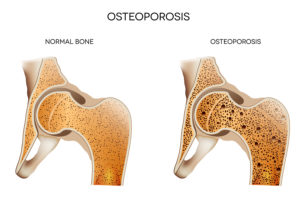Osteopenia is a warning sign that your aging relative is on their way to developing full-blown osteoporosis. It is a condition characterized bones that are weaker than normal, but not to the point that the senior has osteoporosis. Understanding osteopenia can help family caregivers to prevent further bone health deterioration.
Osteopenia Basics

Most people reach their peak bone density when they are around the age of 30. Osteopenia usually happens after age 50. It happens when new bone tissue doesn’t form as quickly as old tissue is lost.
Doctors measure bone density using a bone density scan. The results are reported as a T score. People with osteoporosis have a T score that is higher than -2.5 but lower than -1.0. When the T score reaches -2.5 or lower, the senior is diagnosed with osteoporosis.
Some people are genetically predisposed to getting osteopenia because of a family history of it. Women also get the condition more often than men do. The reason for this is that women tend to have a lower bone mass than men do to begin with. They also typically have a longer lifespan than men do.
Causes of Osteopenia
Osteopenia can be caused by medical conditions, lifestyle changes, or a combination of both. Some medical conditions and treatments that can lead to osteopenia are:
• Celiac disease that is not treated.
• Hyperthyroidism. Using too much thyroid medication may also contribute to the problem.
• Chemotherapy and radiation.
• Some medications, such as steroids and anti-seizure medications.
Some lifestyle choices that increase the risk for osteopenia are:
• Not getting enough calcium or vitamin D.
• Lack of exercise.
• Smoking.
• Drinking excess alcohol.
• Carbonated beverages.
Preventing Osteoporosis
Even if your aging relative already has osteopenia, it may still be possible to keep it from progressing into osteoporosis. Experts recommend taking the following steps:
• Increase Calcium Intake: Good sources of calcium include dairy products, spinach, broccoli, dried beans, and salmon.
• Increase Vitamin D: Vitamin D is necessary for the body to absorb calcium. Seniors can get vitamin D from eggs, oily fish, and foods that have been fortified with vitamin D.
• Exercise: Weight bearing exercises can slow bone loss.
Elderly care providers can assist seniors to prevent osteoporosis. An elderly care provider can prepare meals and snacks that contain foods rich in calcium and vitamin D. An elderly care provider can even take the older adult shopping to purchase food. In addition, an elderly care provider can assist the older adult to engage in weight bearing exercises by driving them to the gym or watching over them while they exercise at home.
If you or an aging loved-one are considering Elderly Care Slaton, TX, please contact the caring staff at Best In-Home Care (806) 412-0723.
Sources
https://www.verywellhealth.com/osteopenia-what-you-need-to-know-190172
https://www.webmd.com/osteoporosis/guide/osteopenia-early-signs-of-bone-loss#1
https://www.healthline.com/health/osteopenia

